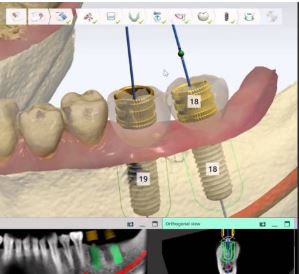Introduction
In the world of modern dentistry, precision and innovation have become pivotal for successful outcomes. One ground-breaking advancement that has revolutionized dental procedures is guided surgery. Guided surgery in dentistry is a technique that combines digital technology, 3D dental scans and computer-guided systems to plan and execute dental implant placements, extractions, and other surgical procedures with unparalleled accuracy. In this blog, we’ll delve into the concept of guided surgery, its benefits, the technology behind it, and its impact on the dental field.
Understanding Guided Surgery
Guided surgery, often referred to as computer-guided surgery or computer-assisted surgery, is a sophisticated approach that enhances the precision of dental procedures. It involves the utilization of digital tools and CBCT scan to create a virtual surgical plan. This plan is then used to fabricate surgical guides, custom-made templates that assist dentists in precisely positioning dental implants or conducting other oral surgeries.
Key Benefits of Guided Surgery
- Enhanced Precision: Guided surgery minimizes the margin of error, making it possible to achieve near-perfect implant placement. This precision leads to better aesthetic and functional outcomes.
- Predictable Results: Dentists can predict the final result with greater accuracy, ensuring that the implant or surgical procedure aligns perfectly with the patient’s anatomical and aesthetic needs.
- Minimized Discomfort: Guided surgery is typically less invasive, resulting in reduced post-operative discomfort and a quicker recovery time for patients.
- Shortened Treatment Time: The enhanced accuracy of guided surgery often means shorter surgery times, reducing the time patients spend in the dental chair.
- Increased Safety: The pre-planning involved in guided surgery helps avoid complications during the procedure, contributing to a safer surgical experience.
Technology Behind Guided Surgery
- Cone Beam CT Scan: The CBCT scan is a key component of guided surgery. It provides a high-resolution CBCT scan of the patient’s oral and maxillofacial region, allowing dentists to visualize the surgical site in detail.
- Computer-Aided Design (CAD): CAD software is used to plan the surgery digitally. Dentists can precisely position the implant or map out the surgical procedure on a computer before the actual surgery takes place.
- 3D Printing: Once the digital plan is finalized, it can be used to create a custom surgical guide using 3D printing technology. These guides are tailored to fit the patient’s unique anatomy.
- Navigation Systems: During surgery, dentists can use real-time navigation systems that display the surgical guide’s position relative to the patient’s mouth. This aids in the precise execution of the procedure.
Applications of Guided Surgery
Guided surgery has found applications in various dental procedures, including:
- Dental Implant Placement: Precisely positioning dental implants is a common application of guided surgery. This ensures optimal anchorage and minimizes the risk of complications.
- Tooth Extractions: Guided surgery can assist in complex extractions, preserving surrounding bone and minimizing damage to adjacent structures.
- Bone Grafting: When bone grafting is required before implant placement, guided surgery helps ensure the graft material is harvested and/or precisely placed.
- Orthognathic Surgery: Guided surgery is used in corrective jaw surgery to achieve precise alignment of the jaw.
- Endodontic Surgery: Guided surgery can aid in performing precise endodontic surgeries, such as apicectomy (removal of the tip of a tooth’s root).
Conclusion
Guided surgery in dentistry represents a significant leap forward in precision and predictability. It leverages cutting-edge technology to enhance the patient experience and improve clinical outcomes. As technology continues to advance, guided surgery is likely to become even more sophisticated and widely adopted in the dental field. With its potential to reduce complications, shorten treatment times, and enhance patient comfort, guided surgery is indeed a game-changer in modern dentistry. Dentists who embrace this innovation are well-positioned to provide their patients with the highest level of care and satisfaction.
Want to learn more about our Implant Planning and Surgical Guide manufacturing service? Click here to book your place on our free CPD Session How to Embrace the Digital Workflow or contact [email protected]

